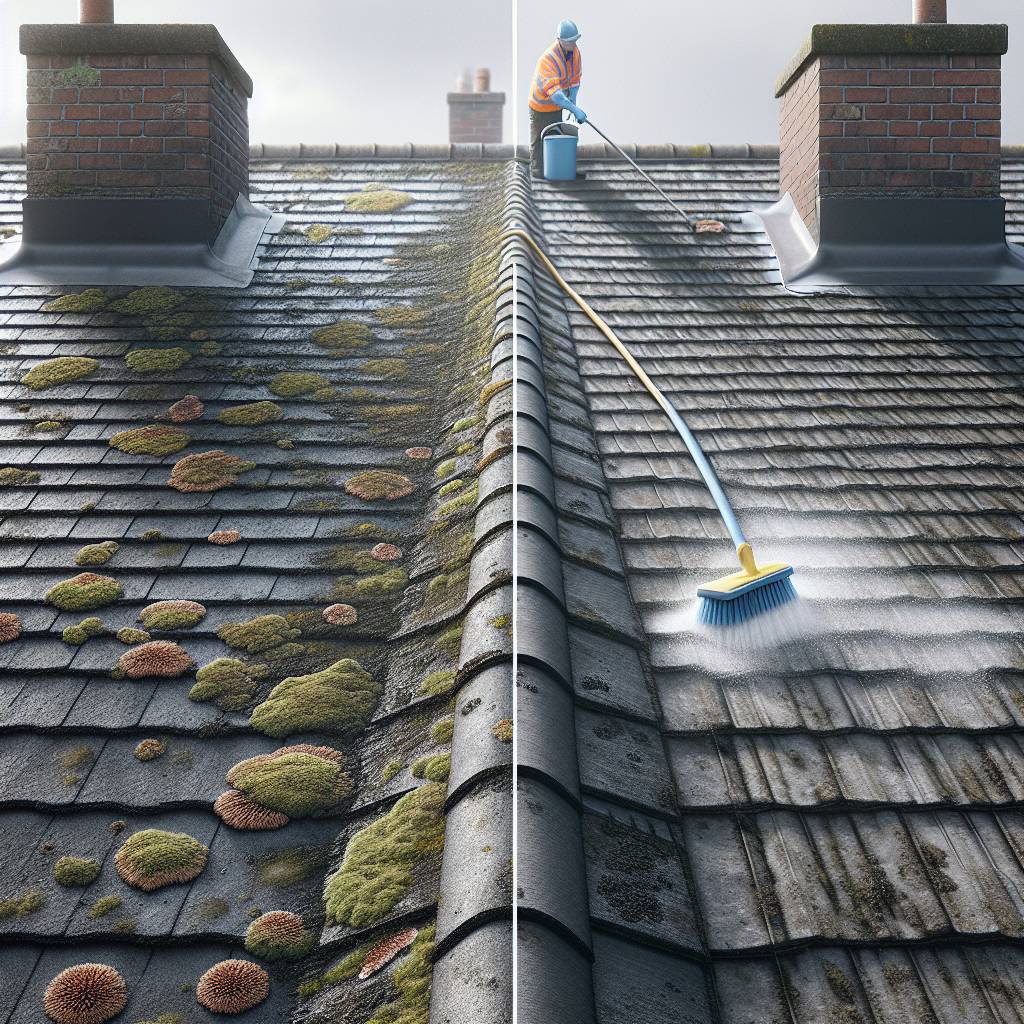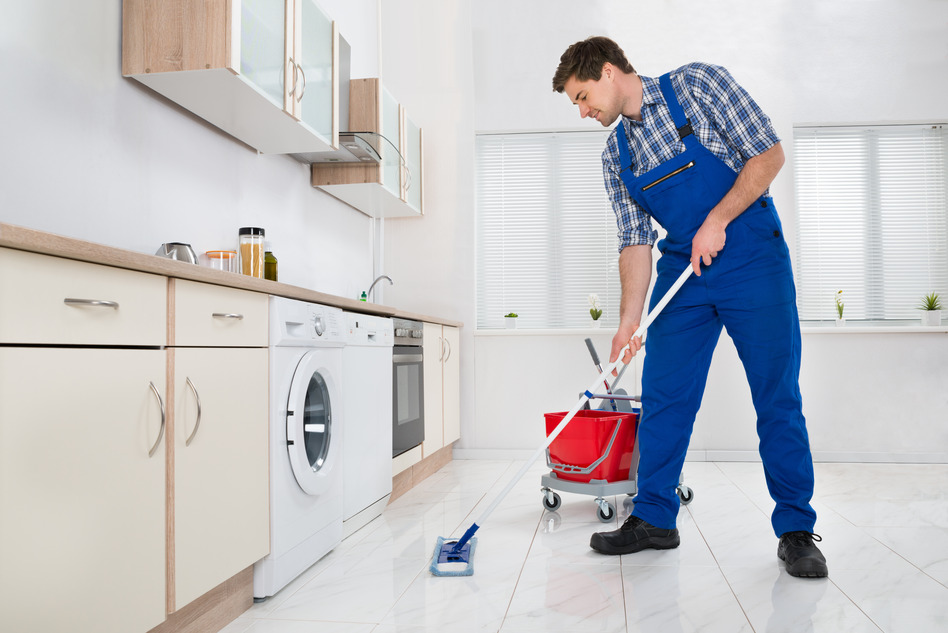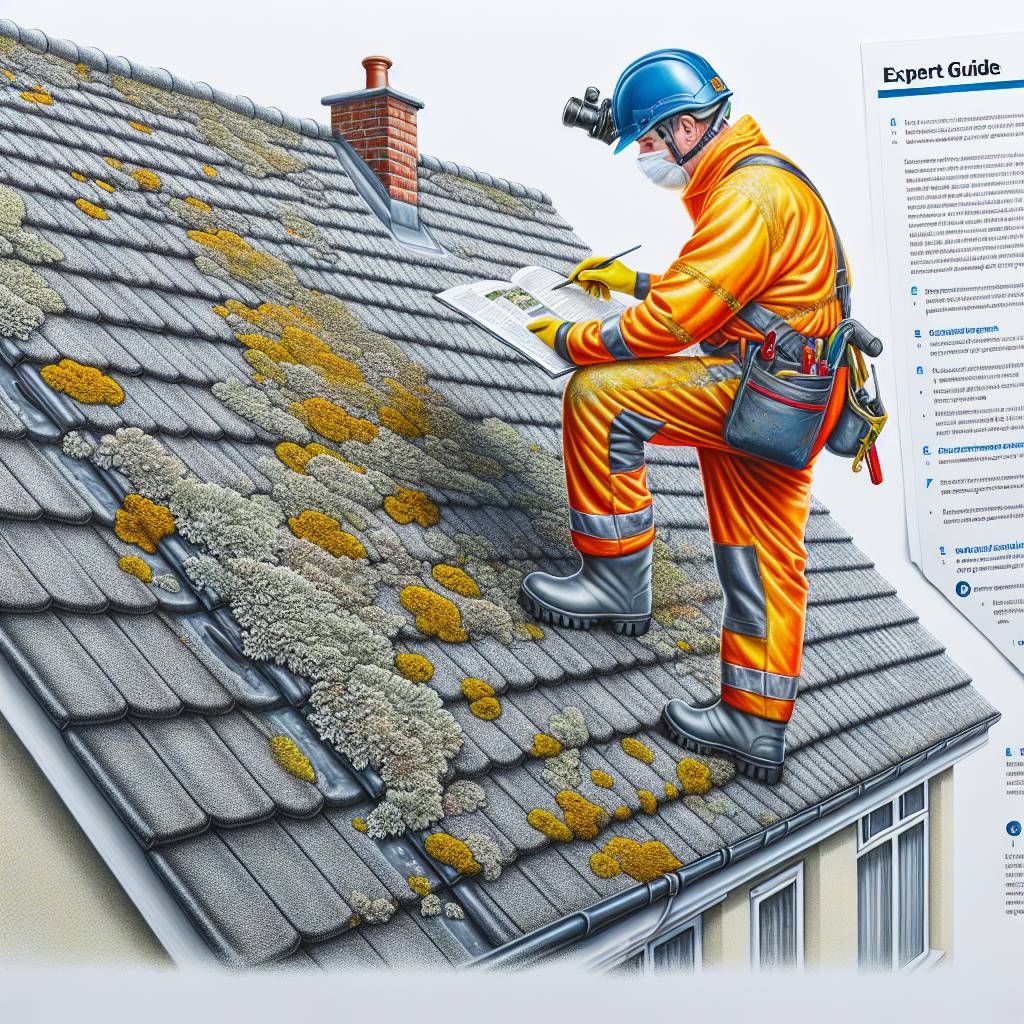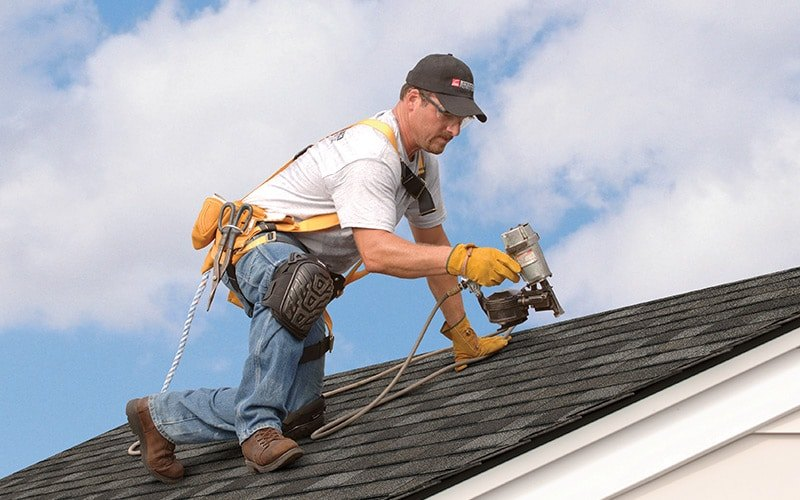Maintaining your roof regularly can be the difference between a pristine rooftop and one plagued by unsightly lichen growth. By staying proactive with regular maintenance, you can effectively thwart potential lichen problems, green algae, and fungus before they take root. Neglecting routine care, on the other hand, may result in an inviting environment for lichen to thrive, leading to costly repairs and aesthetic concerns down the line.
Roof upkeep serves as a protective shield against invasive organisms like lichen. This simple preventive measure not only safeguards your roof’s integrity but also enhances its curb appeal. In this post, we’ll delve into how consistent maintenance acts as a deterrent to lichen infestations and fungus protection, and explore practical tips for keeping your roof free from these unwanted guests, leaks, and extending its lifespan.
Key Takeaways
- Regular roof maintenance is crucial in preventing lichen growth and preserving the longevity of your roof.
- Keep your roof clean and free from debris to minimize lichen formation, and ensure proper sun exposure and ventilation to discourage its growth.
- Professional roof inspections play a vital role in identifying and addressing lichen issues early on.
- Safely removing lichen from your roof is essential to prevent damage and extend its lifespan.
- Investing in consistent roof maintenance not only prevents lichen problems but also provides long-term benefits by avoiding costly repairs and replacements.
- Prioritizing proactive measures against lichen growth can save you time, money, and the hassle of dealing with extensive roof damage in the future.
Understanding Lichen’s Impact on Roof Longevity
Impact of Lichen Growth
Lichen, a combination of algae and fungi, might seem harmless at first glance. However, understanding the problem of fungus on your roof’s longevity is crucial. As lichen spreads across the surface of your roof, it gradually deteriorates the roofing materials. The roots of the lichen penetrate the shingles or tiles, causing damage that compromises their integrity over time.
This growth also leads to water retention and fungus on your roof. When moisture gets trapped beneath a layer of lichen, it can seep into cracks and crevices in the roofing material. This prolonged exposure to moisture can result in rotting or warping of the underlying structure. Ultimately, if left untreated, lichen can compromise the structural integrity of your entire roof.
Regular maintenance plays a vital role in preventing these issues from arising and safeguarding your roof against potential damages caused by lichen growth.
Importance of Regular Roof Maintenance
By conducting regular inspections and cleaning sessions for your roof, you can effectively prevent lichen problems from taking root. Removing debris such as leaves and twigs helps eliminate potential breeding grounds for lichens while also preventing water accumulation.
Furthermore, applying roof coatings specifically designed to inhibit fungal growth can serve as an additional protective measure against lichens. These coatings act as a barrier that prevents algae and fungi from thriving on your roof’s surface.
In addition to proactive measures like coating applications, scheduling periodic professional cleanings for your roof ensures that any early signs of lichen growth are promptly addressed before they escalate into more severe issues.
Key Steps in Regular Roof Maintenance for Lichen Prevention
Regular Cleaning
Regular cleaning of your roof is essential to prevent lichen problems. Regular cleaning involves removing debris from the roof’s surface, which can accumulate and create a hospitable environment for lichen growth. By keeping the roof clear of leaves, branches, and other organic matter, you reduce the chances of lichens finding a place to take root and thrive. This maintenance task should be performed at least twice a year to ensure that no buildup occurs.
Another aspect of regular cleaning is clearing out gutters and downspouts. Clogged gutters can lead to water pooling on the roof, creating damp conditions that are conducive to lichen growth. Ensuring that water flows freely off the roof prevents excess moisture from lingering and promotes an environment inhospitable to lichens.
Trimming Overhanging Branches
Trimming overhanging branches near your roof is another crucial step in preventing lichen problems. Overhanging branches provide shade and trap moisture on the roof’s surface, creating an ideal habitat for lichens to flourish. By trimming these branches back, you allow more sunlight onto the roof while reducing trapped moisture levels—both factors that discourage lichen formation.
In addition to preventing lichens, trimming overhanging branches also reduces other potential risks such as falling limbs or damage caused by rubbing against the shingles during windy conditions or storms.
Installing Zinc or Copper Strips
Applying zinc or copper strips along the ridge line of your roof can effectively inhibit lichen growth. These metals release ions when exposed to rainwater, which then run down the surface of the shingles below them. The ions act as natural biocides that deter various organisms including algae and fungi like lichens from taking hold on your roofing material.
The installation process involves placing metal strips just below the ridge cap shingles so they’re not visible from below but still effective at inhibiting unwanted biological growth above them.
Recognizing Signs of Lichen Growth on Your Roof
Identifying Lichen Growth
When inspecting your roof, keep an eye out for small, green or gray patches. These are clear signs of lichen growth. Lichens often exhibit a moss-like or crusty appearance, making them easily distinguishable from other roof issues. Areas with limited sun exposure such as the north-facing slopes are more susceptible to lichen growth due to the dampness and shade.
Lichens thrive in shady, damp environments where organic debris accumulates. Therefore, it’s essential to check areas around chimneys, under overhanging trees, and near vents for any signs of lichen colonies. When left unchecked, these colonies can lead to serious damage that may necessitate costly roof replacement.
Impact of Lichen Growth
If not addressed promptly, lichens can cause significant problems for your roof. They have the potential to trap moisture against the surface of your roof shingles or tiles which can result in water leaks and rotting wood underneath. This trapped moisture also creates an ideal environment for other organisms like algae and fungus to thrive.
Moreover, lichens can compromise the integrity of your roofing materials by slowly penetrating and breaking down their structure over time if not removed regularly through proper maintenance practices. This deterioration increases the likelihood of developing roof leaks, leading to water damage inside your home.
To prevent these detrimental effects on your roof caused by lichen growths like mosses and algae formations you should be proactive about maintaining your roof properly.
Effective Methods for Preventing Lichen Formation
Regular Cleaning with Mild Detergent Solution
Regular cleaning of your roof is crucial in preventing lichen problems. Use a gentle solution of water and mild detergent to remove dirt and organic matter that lichens thrive on. This simple yet effective method helps eliminate the conditions conducive to lichen growth. By keeping your roof clean, you can significantly reduce the likelihood of lichens taking hold.
Lichens require a suitable environment to flourish, so by removing their food source through regular cleaning, you can effectively deter their formation. This proactive approach not only enhances the aesthetic appeal of your roof but also serves as a protective measure against potential damage caused by persistent lichen growth.
Application of Moss and Algae Inhibitor
Applying a biodegradable moss and algae inhibitor is an excellent way to prevent lichen growth on your roof. These inhibitors are specifically formulated to impede the development of moss, algae, and lichens without causing harm to the environment or compromising the integrity of your roofing materials. By using such inhibitors as part of your maintenance routine, you create an inhospitable environment for these organisms.
The application process is relatively straightforward and provides long-lasting protection against various types of biological invaders that could compromise the condition of your roof over time. With this preventive measure in place, you can enjoy peace of mind knowing that your roof is shielded from unsightly lichen infestations.
Ensuring Proper Attic Ventilation
Proper ventilation in your attic plays a pivotal role in minimizing moisture buildup on the roof, which can contribute to favorable conditions for lichen growth. When moist conditions persist due to inadequate ventilation, it creates an inviting habitat for lichens to take root and spread across your roofing structure.
The Role of Professional Roof Inspections in Lichen Control
Early Detection and Identification
Professional roof inspections play a crucial role in preventing lichen problems by identifying early signs of lichen growth. These experts are trained to spot even the smallest patches of lichens, which may not be visible to an untrained eye. By catching these signs early, they can recommend appropriate treatments or preventive measures before the problem escalates. For instance, if they notice small areas with lichen growth during an inspection, they can suggest specific cleaning methods or apply protective coatings to prevent further spread.
Lichens are often mistaken for harmless discoloration on roofs, but professionals understand that their presence can lead to more significant issues if left untreated. They have the knowledge and experience to differentiate between harmless stains and potentially damaging lichen growth. This level of expertise is essential for maintaining the overall health and longevity of a roof.
Treatment Recommendations and Preventive Measures
When specialists identify lichen infestation during a professional inspection, they can provide tailored recommendations based on the severity of the issue. For example, if there’s minor lichen growth present, they might suggest regular cleaning schedules as a preventive measure. On the other hand, if extensive infestation is detected, professionals may advise more intensive treatments such as chemical applications or targeted cleaning techniques.
These experts can also offer guidance on long-term strategies for preventing future lichen problems. This could involve suggestions for improving roof ventilation or enhancing insulation to create an environment less conducive to lichen growth.
Roof maintenance specialists recognize that addressing insulation issues plays a critical role in preventing lichens from taking hold on roofs due to moisture retention caused by poor ventilation or inadequate insulation levels.
Importance of Sun Exposure and Ventilation in Preventing Lichen
Sunlight’s Role
Increased sunlight exposure is crucial in preventing lichen growth on roofs. When the roof surface receives more sunlight, it dries out faster, creating an environment that is less favorable for lichens to thrive. This means that areas with ample shade or limited exposure to sunlight are more prone to lichen infestation due to the retained moisture.
Lichens require a damp environment to grow, and prolonged wetness facilitates their colonization. By maximizing sun exposure on your roof, you can effectively minimize the moisture retention that encourages lichen development.
Properly trimmed trees or nearby structures may cast shadows on parts of the roof, obstructing sun exposure. It’s essential to keep these obstructions in check by regularly pruning overhanging branches and ensuring adequate clearance around the roof area.
Managing Humidity Through Ventilation
Adequate ventilation plays a pivotal role in reducing humidity buildup within roofing structures. Moisture accumulation provides an ideal breeding ground for lichens; thus, proper ventilation helps mitigate this risk significantly.
By promoting airflow through the attic and under-roof spaces, ventilation systems facilitate moisture evaporation from these areas. This prevents excess humidity from lingering within the roofing structure and subsequently decreases the likelihood of lichen formation.
Installing vents strategically across the roof ensures that air circulates efficiently throughout its entirety. Maintaining clean gutters and downspouts aids in directing water away from the house promptly, further contributing to humidity control.
Reflective Roofing Materials
The installation of reflective roofing materials can also play a crucial role in minimizing heat absorption by your roof surface. These materials have properties designed to reflect solar radiation rather than absorbing it into your home’s interior space. Reflective surfaces help create an unfavorable environment for both excessive heat buildup and subsequent moisture retention—factors that contribute significantly to fostering conditions conducive for lichen growth. Examples of such materials include metal roofs with reflective coatings or light-colored shingles specifically engineered with reflective properties.
Safely Removing Lichen to Protect Your Roof
Gentle Removal Methods
Regular maintenance is key. You can use a soft-bristle brush or a low-pressure power washer to gently remove lichens from the roof’s surface. These methods effectively eliminate lichens without causing any damage to the roofing material underneath. By using gentle removal techniques, you can ensure that your roof remains free of lichen growth while maintaining its structural integrity.
It’s essential to avoid using harsh chemicals or high-pressure washing when removing lichens from your roof. Harsh chemicals can not only harm the environment but also cause damage to the shingles or tiles on your roof. High-pressure washing may dislodge granules from asphalt shingles and compromise their protective layer, leading to potential water leaks and reduced lifespan of the roofing material. Therefore, opting for gentle removal methods is crucial in preventing lichen problems and preserving the longevity of your roof.
Professional Expertise
In addition to DIY efforts, considering professional help for lichen removal can be beneficial in ensuring safe and effective results. Professionals experienced in lichen removal have the expertise and proper equipment required for safely eliminating lichens from various types of roofs without causing any damage. They understand how different roofing materials react to cleaning methods and can tailor their approach accordingly, providing thorough yet gentle cleaning that prevents future issues with lichen growth.
Cost-Benefit Analysis of Cleaning vs. Repairing Lichen Damage
Cost-Effective Maintenance
Regular roof maintenance and preventive cleaning are highly cost-effective strategies for preventing lichen problems. By investing in routine maintenance, you can save a significant amount of money in the long run. This proactive approach helps to avoid costly repairs or premature roof replacement due to extensive lichen damage.
Investing in regular cleaning and preventive maintenance not only extends the lifespan of your roof but also prevents potential issues such as water damage and structural harm caused by lichen growth. For example, simple measures like clearing debris from gutters and removing overhanging branches can prevent excessive moisture buildup, which is conducive to lichen growth.
Professional Lichen Removal
The cost of professional lichen removal is notably lower when compared to repairing structural damage resulting from neglecting lichen growth. Engaging professional services for periodic roof inspections and targeted removal of lichens can effectively control their spread without causing any harm to the roofing material.
Long-Term Benefits of Consistent Roof Maintenance Against Lichen
Preventing Deterioration
Regular roof maintenance plays a crucial role in preventing lichen-related deterioration. By keeping your roof clean and well-maintained, you can effectively inhibit the growth of lichen, moss, and algae. This proactive approach helps to safeguard the integrity of your roof by minimizing the risk of damage caused by these organic invaders. For instance, removing debris from your roof’s surface ensures that moisture doesn’t get trapped, which could otherwise create an ideal environment for lichen to thrive.
Consistent maintenance also extends the lifespan of your roof by preventing lichen from compromising its structural integrity. By addressing this issue promptly and regularly inspecting for any signs of lichen growth, homeowners can maintain their roofs in optimal condition for a longer period. This not only saves money on potential repairs but also contributes to overall peace of mind regarding the health and longevity of their roofs.
Enhancing Curb Appeal and Property Value
In addition to preserving the health and functionality of your roof, regular maintenance significantly enhances curb appeal and increases property value. A clean, well-maintained roof adds to the visual aesthetics of a home’s exterior. It creates an impression that reflects diligence in caring for one’s property while boosting its overall attractiveness.
Moreover, when it comes time to sell a house or have it appraised, having a well-maintained roof can be a major selling point. Potential buyers are more likely to be attracted to properties with roofs that are free from unsightly lichen growth or other issues related to neglect or lack of upkeep.
Avoiding Costly Issues Down the Line
By addressing lichen growth through regular maintenance routines such as cleaning and inspections, homeowners can avoid potential leaks and other costly issues down the line. Lichens are known for their ability to retain moisture against surfaces they grow on; if left unchecked over time they may lead to water infiltration beneath shingles or tiles causing rotting wood underneath.
Taking proactive measures through routine cleaning not only prevents this situation but also saves homeowners from expensive repair bills associated with water damage caused by neglected roofing problems.
Closing Thoughts
You’ve learned how vital regular roof maintenance is in preventing lichen problems. By understanding the impact of lichen on your roof’s longevity and implementing key preventive measures, you can safeguard your investment. Recognizing the signs of lichen growth, ensuring proper ventilation and sun exposure, and considering professional inspections are all crucial steps in maintaining a lichen-free roof. Remember, the long-term benefits of consistent roof maintenance far outweigh the costs and efforts involved in dealing with lichen damage.
Take action today to protect your roof from lichen. Schedule a professional inspection, clear debris regularly, and consider implementing preventive treatments. Your proactive approach to roof maintenance will not only enhance the aesthetic appeal of your property but also extend the lifespan of your roof, saving you from costly repairs down the road.
Frequently Asked Questions
How does lichen affect the longevity of a roof?
Lichen can deteriorate roofing materials, leading to structural damage and reduced lifespan. It’s crucial to address lichen growth promptly through regular maintenance to avoid costly repairs or premature replacement.
What are the key steps in regular roof maintenance for preventing lichen?
Regular cleaning, proper ventilation, and sunlight exposure are essential for preventing lichen growth. Conducting professional inspections and safely removing any existing lichen also play vital roles in maintaining a healthy roof.
How can I recognize signs of lichen growth on my roof?
Look out for small green or white patches on your roof surface, especially in shaded areas. Lichens may appear as crusty or leafy formations. Regular visual inspections will help you spot early signs of infestation.
What methods are effective for preventing lichen formation on roofs?
Preventive measures include applying zinc strips along the ridge line, trimming overhanging branches to increase sunlight exposure, and keeping gutters clean to avoid moisture buildup—all of which deter lichen growth.
Why is sun exposure and ventilation important in preventing lichen growth?
Sunlight inhibits moisture retention while proper ventilation helps maintain dry conditions that discourage fungal growth. Together, these factors create an environment less conducive for lichens to thrive on your roof.
Is it safe to remove lichen from my roof myself?
Safely removing lichens requires specific techniques and products like gentle cleaning solutions or low-pressure washing. For safety reasons and optimal results, consider hiring professionals who have the expertise and equipment necessary for this task.






